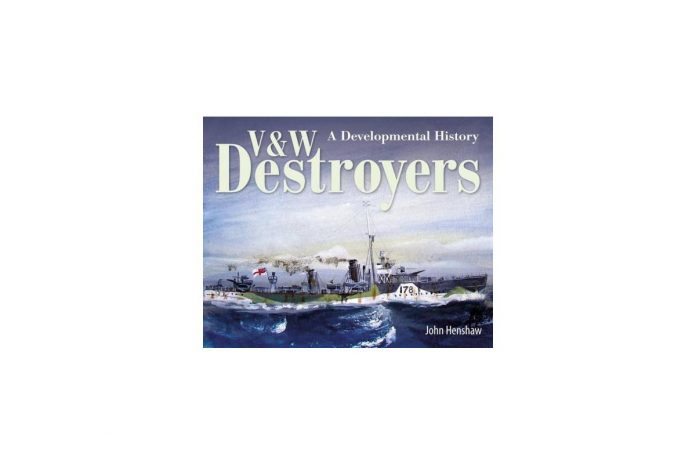
V & W Destroyers: A Developmental History. By John Henshaw. Seaforth Publishing, Barnsley, 2020.
Reviewed by Greg Swinden
Overall a very interesting book tracing the development and service of the V & W class destroyers. This book is written in an easy going conversational style and is well-illustrated with excellent line drawings, produced by the author, of the various ships discussed.
The author states the drawings are not suitable for use by model makers – but only an expert in that field would be able to pick any errors. The book is also well illustrated with ship photos but some may not approve of some of the sources such a Wikimedia and the like.
Norman Friedman and Antony Preston, who have already written on this subject, are well cited but Henshaw does delve a little deeper into the construction and testing aspects of destroyers in the pre-World War I era. The Royal Navy Directorate of Naval Construction (DNC) was fixated on speed, as the main criteria for the torpedo boat destroyers (later just destroyers). This gave the main builders (such as Thornycroft, Yarrow, Laird, etc.) ‘free rein’ in many respects to design a vessel within broad parameters of length and displacement; thus leading to some innovative designs (as well as some failures) but enabled experimentation and risk taking to occur which led to more effective ships. Many vessels were produced ‘on speculation’ with the Royal Navy generally taking all that were produced which did lead to a somewhat mixed fleet.
Some companies produced ships capable of 35+ knots during trials (but often without a full load of fuel, ammunition and stores which once loaded reduced the vessels speed). This innovation and risk taking enabled ship design and weaponry to evolve in Britain at a faster rate than in other countries but also in some-ways stifled changes (especially those being undertaken in the US such as high angle weapon design and use of additives in boiler water to reduce the frequency of cleaning). The annual DNC call for destroyer designs also enabled a rolling shipbuilding program to exist but the designs from each yard varied. This would be current logistician’s nightmare in trying to provide spare parts and ensure consistency across the fleet – not an issue in the early 1900s when replacement parts were either made onboard from scratch or in the shipyard. For example the RAN’s River Class (or Parramatta Class) of 1910 were at the tail end of the production run thus incorporating changes not present in their older RN sisters.
Henshaw traces the history of Royal Navy destroyers from the late 1890s through to the creation of V & W Class, in the later part of World War I, as well as the need for larger flotilla leaders and the discussion of the benefits of the 4 inch gun vice the 4.7 inch gun. Conversion of some ships as fast minelayers is also considered. The V & W class became the turning point in RN destroyer design which influenced the inter-war RN building program which from 1927 onwards saw an annual build of destroyers culminating in the famous Tribal class in 1936. This rolling shipbuilding activity also enabled the Royal Navy to divest older and less capable destroyers more quickly with the average age of destroyers at the outbreak of war in 1939 being about 15 years.
Many of the V & W class sailed on into World War II service vice some other destroyer classes; such as the S class that were also late World War I builds, but were scrapped in the early 1930s. Chapter 10 of the book is devoted to the RAN’s V & W class ships of the Scrap Iron Flotilla; providing a good potted history of these ships careers. By 1942 the V & W class days were numbered; as more modern destroyers, especially the Tribal class, took on the front line roles. The older destroyers became fast supply vessels or were modified as training ships or long range convoy escorts (by converting one boiler room into fuel storage). Either way the V & W class became one of the iconic destroyers of the Second World War.
Some readers may not like the authors writing style (which is more akin to a podcast script) and at times the human factor is under-done (i.e. the ship specifications data has everything but the complement numbers so it is difficult to track crew size changes over the period being reviewed). For ‘ship spotters’ the appendices provide some very good data on British destroyers from the 1890s to the end of World War I.
For those interested in learning more about the V & W class destroyers I would still recommend Norman Friedman’s British Destroyers: From Earliest Days to the Second World War: An Illustrated Design History as the definitive source; but have a copy of Henshaw’s book close at hand as well.
About the Author
John Henshaw was educated at Wesley College and Melbourne University. He actively considered a naval career but instead became a chartered surveyor designing and constructing buildings and also engaging in most aspects of property development. He currently resides in Victoria.
He has written three other nautical books being;
Narrow boating for novices (2017)
Town class destroyers – A Critical Assessment (2018)
Liberty’s Provenance – The evolution of the Liberty Ships from its Sunderland origins (2019)
In 2008 his essay HMAS Albatross: White Elephant or Wolf in Sheep’s Clothing? won 2nd prize in the Navy League of Australia essay competition. He has also written various articles for yachting magazines.



